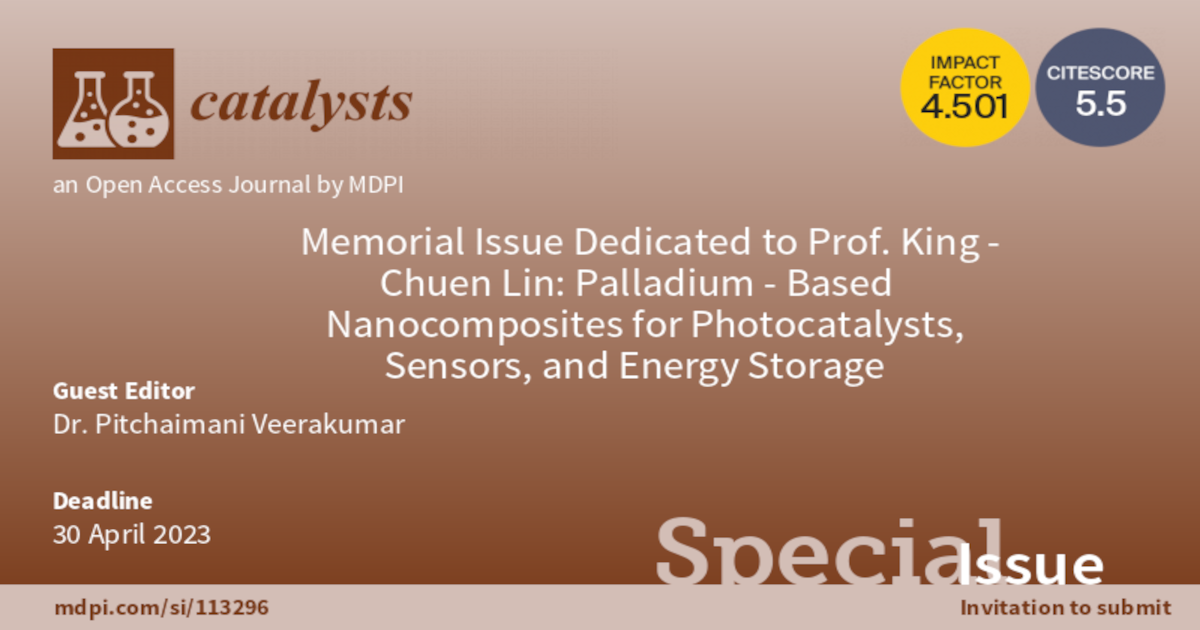- 4.0Impact Factor
- 7.6CiteScore
- 17 daysTime to First Decision
Memorial Issue Dedicated to Prof. King-Chuen Lin: Palladium-Based Nanocomposites for Photocatalysts, Sensors, and Energy Storage
This special issue belongs to the section “Catalysis for Sustainable Energy“.
Special Issue Information
Dear Colleagues,
This Special Issue of Catalysts is dedicated to Prof. King-Chuen Lin (1953–2022), a distinguished Professor of National Taiwan University (NTU), Taiwan. Professor Lin has spent 38 years in the Department of Chemistry of NTU, and he has cultivated the talents of many students in chemistry who have gone on to develop successfully in academia or industry. Professor Lin is a humble person, always greeting people with a smile, and his gentle tone, careful explanations and patient listening to the other party's discussion has impressed everyone who has come into contact with him. In addition, he also takes great care of students, both in life and in schoolwork, and the demeanor of such a warm scholar is deeply rooted in the hearts of the people.
Professor Lin's research results are very fruitful, with 276 academic papers published in internationally renowned chemical journals. He was awarded the Outstanding Research Award of the National Academy of Sciences in 1990-1996; Distinguished Researcher of the National Academy of Sciences in 1996-2002; Tenured Distinguished Professor of NTU in 2006; Academic Award of the Chinese Chemical Society in 2009; Academic Award of the Ministry of Education in 2014; The Richard B. Bernstein Award of the International Conference on Dynamics in 2018; the 23rd National Lecture Moderator Award of the Ministry of Education in 2019; and many other awards. Thus, Professor Lin has influence the community of chemists across the globe, especially in the field of photo-dissociation, reaction dynamics in gas and condensed phases, atmospheric chemistry, single-molecule spectroscopy, catalysis, energy stoagae, and sensors.
This Special Issue will focus on the most current developments and advancements in the field of Pd-based nanocomposites that are important for photocatalysis, electrochemical sensors, and energy storage.
The development of efficient electrocatalysts has been a top priority in recent years in order to speed up the reaction process and minimize energy consumption. As electrocatalysts, solid-supported Pd-based nanocomposites appear as viable alternatives to the current benchmark for energy conversion, because of their well-developed electronic structure, large surface area, and surface active sites. We also hope to discuss recent advances in environmentally friendly and cost-effective approaches for the synthesis of mono-, bi-, and multi-metallic supported nanocomposites, such as graphene-based materials, carbon nanotubes, semiconductor metal oxides, metal sulfides, graphitic carbon nitride (g-C3N4), MXene, and other active materials. Electrochemical sensors could be a viable alternative for environmental monitoring, overcoming many of the shortcomings of current analysis methods. In particular, Pd nanoparticles can also provide a preferred Z-scheme transfer pathway for electrons, which can generate higher redox active species. As a result, this Special Issue offers new perspectives on the development of palladium-based nanocomposites for photocatalysts, sensors, and energy storage applications. Furthermore, the current Special Issue will focus on recent advances in the synthesis and characterization of supported Pd nanocatalysts for sustainable applications.
Dr. Pitchaimani Veerakumar
Guest Editor
Manuscript Submission Information
Manuscripts should be submitted online at www.mdpi.com by registering and logging in to this website. Once you are registered, click here to go to the submission form. Manuscripts can be submitted until the deadline. All submissions that pass pre-check are peer-reviewed. Accepted papers will be published continuously in the journal (as soon as accepted) and will be listed together on the special issue website. Research articles, review articles as well as short communications are invited. For planned papers, a title and short abstract (about 250 words) can be sent to the Editorial Office for assessment.
Submitted manuscripts should not have been published previously, nor be under consideration for publication elsewhere (except conference proceedings papers). All manuscripts are thoroughly refereed through a single-blind peer-review process. A guide for authors and other relevant information for submission of manuscripts is available on the Instructions for Authors page. Catalysts is an international peer-reviewed open access monthly journal published by MDPI.
Please visit the Instructions for Authors page before submitting a manuscript. The Article Processing Charge (APC) for publication in this open access journal is 2200 CHF (Swiss Francs). Submitted papers should be well formatted and use good English. Authors may use MDPI's English editing service prior to publication or during author revisions.
Keywords
- palladium
- semiconductor metal oxide
- photocatalysts
- electrochemical sensors
- energy storage

Benefits of Publishing in a Special Issue
- Ease of navigation: Grouping papers by topic helps scholars navigate broad scope journals more efficiently.
- Greater discoverability: Special Issues support the reach and impact of scientific research. Articles in Special Issues are more discoverable and cited more frequently.
- Expansion of research network: Special Issues facilitate connections among authors, fostering scientific collaborations.
- External promotion: Articles in Special Issues are often promoted through the journal's social media, increasing their visibility.
- e-Book format: Special Issues with more than 10 articles can be published as dedicated e-books, ensuring wide and rapid dissemination.

